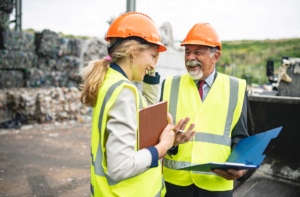The Importance of a Disaster Relief Plan
From hurricanes, flooding, and tornadoes to fires, earthquakes, and everything in between, natural disasters can be heartbreaking and wreak havoc on entire communities and the local businesses that serve them. They can happen anywhere, anytime, and they often emerge with very little warning.
In 2021 alone, the United States had more than 20 major natural disasters, totaling $145 billion in damages. Once disaster strikes, safety is the primary concern. Residents and businesses must evacuate or find a safe place to ride out the disaster. After the initial danger subsides and the active phase of the disaster ends, the painful process of navigating the aftermath begins.
Disaster cleanup is often emotionally painful, time-consuming, and requires the right expertise to ensure everyone’s safety while working as efficiently as possible. If your property (or properties) suffers notable damage, you’ll likely have large amounts of debris, garbage, and waste that need to be hauled away. That’s why having a disaster relief clean-up plan in place before catastrophe strikes is so important.
We wanted to take time to look in more detail at the disaster recovery and debris cleanup process following catastrophes.
Why is Disaster Recovery So Slow?
As homeowners and business owners emerge or return home, they find things like damaged roofs, fallen trees, shattered windows, standing water, ruined merchandise and valuables, miscellaneous debris, and more. In fact, just one disaster can produce thousands to millions of tons of waste.
The sheer volume of leftover debris overwhelms local waste companies, leaving many communities struggling with waste for months (and even years). In addition, communities often struggle with a lack of funding and slow emergency assistance, leaving many residents and business owners to fend for themselves – despite the best-laid disaster relief plans.
While we may have historical context for handling natural disasters, every event is unique, making cleanup and recovery different for each situation and community. Disaster relief is slow because disasters are devastating and local governments are often underprepared to handle them; which is why well-developed disaster relief plans are so pivotal.
The Importance of Disaster Relief Plans After Catastrophe
While there are many steps to disaster relief, the first step of cleanup and recovery following a catastrophe is often hauling away the immediate debris. To accomplish this task, you need a reliable junk removal solutions provider with the right equipment to assist – as well as a company that knows what to do with the debris once they pick it up.
Disaster clean-up services, which often involve various types of trucks and trailers, are beneficial for several reasons:
1. They Provide a Quick (and Sustainable) Solution to Standing Debris
Debris collection is often expensive, slow, and dangerous, leaving many communities and businesses in flux for much longer than anticipated following disasters. When clean-up vehicles are hired from reputable providers with sustainable disposal options, you can quickly get rid of your debris and trust that it’s being handled responsibly.
2. Removing Debris Quickly Helps Boost Morale
Communities understand that rebuilding takes time. Still, quick cleanup can boost a community’s morale and help foster hope that things will soon return to normal. In other words, having multiple resources to address debris removal after a disaster has a significant positive impact on your (and your community’s) emotional well-being.
3. They Protect You From Unscrupulous Providers
Unfortunately, disasters can draw in a lot of shady characters hoping to make a quick buck. From fraudulent insurance adjusters to fake contractors, it can be hard to tell who you can trust. Just because someone shows up with a truck doesn’t mean you should pay them to take away your debris. Here’s why.
If they’re not honest (or ill-equipped), they might just load up your debris and dump it on your neighbor’s lawn down the road. While that might temporarily mitigate your problem, it doesn’t do much to help the community at large. That’s why working with trusted providers for disaster clean-up is so critical.
Incorporating Disaster Response and Clean-Up Solutions Into Your Relief Plan
Once you decide to use disaster clean-up services, it could be difficult to find a provider. In fact, locating vehicles and drivers for disaster relief in your area following a catastrophe can be incredibly challenging. That’s where we can help.
At CheckSammy, we have various types of vehicles and trucks available during storms when no one else has them. Our services do not require a container to be left on site – and after our drivers load it for you, we take it away to dispose of the items as sustainably as possible. We also offer power washing services to help local businesses and residents to return their properties to their former appearance.
With our national partnerships, we can handle your waste and debris quickly and sustainably so your community can get back to normal as fast as possible. Contact us today to get service in your area.
See Our Services
Create a custom solution to meet your waste and sustainability goals. Contact us today!
Continue reading
Dive deeper into the CheckSammy Blog by reading one of our posts below
Feeling the Pain of Higher Resident Turnover? Apartment Junk Removal Can Help
If you’re a property manager, you’ve probably had a significant increase in tenant turnover over the last couple of years. So it’s no wonder apartment junk removal may be top of mind for you right now. There are several reasons for this shift. For one, the housing market is on fire right now. In 2020 […]
Read More About Feeling the Pain of Higher Resident Turnover? Apartment Junk Removal Can HelpSetting Up a Community E-waste Recycling Program
E-waste is the fastest-growing municipal waste stream according to the EPA, yet e-waste recycling isn’t keeping pace. In fact, only 12.5% of all e-waste is recycled, reports the EPA. Starting a community e-waste recycling program is a terrific way to ensure hazardous e-waste, like lithium-ion batteries, doesn’t end up in your community’s landfill. Creating an […]
Read More About Setting Up a Community E-waste Recycling ProgramWaste Management’s Role in the Circular Economy
Establishing a waste management program for your business or community is one of the best ways you can contribute to the circular economy. Here’s everything you need to know about waste management’s role in the circular economy (and how to get involved). What Is the Circular Economy? Our current economic model is all about taking […]
Read More About Waste Management’s Role in the Circular Economy5 Reasons to Consider a Textile Recycling Program for Your Organization
Americans sent more than 17 million tons of textiles to landfills in 2018, a volume that is only increasing every year, reports the Environmental Protection Agency. When you think about the fact that it can take over 200 years for textiles to decompose, it’s easy to grasp how large textile waste’s contribution is to the […]
Read More About 5 Reasons to Consider a Textile Recycling Program for Your Organization8 Benefits of Environmentally Friendly Power Washing Services
If you’re into maintaining the curb appeal of your business or home, then you’ve probably heard of pressure washing. Pressure cleaning involves using high-pressure water spray to remove grime, mold, dust, paint, mud, and other junk from objects or surfaces. Many people worry that pressure washing isn’t good for the environment, but this couldn’t be […]
Read More About 8 Benefits of Environmentally Friendly Power Washing ServicesWhy Our Customers Love Our Full-Service Junk Removal
If you’re looking for full-service junk removal services, you’ve come to the right place. CheckSammy is a one-stop shop for all your junk removal and sustainability needs. From our affordability, simplicity, and unrivaled turnaround times to our innovative sustainability solutions and patented technology and data, it’s clear why some of North America’s biggest companies choose […]
Read More About Why Our Customers Love Our Full-Service Junk RemovalTips for a Stress-Free Move From An Eco-Friendly Junk Removal Company
What does an eco-friendly junk removal company know about moving? Quite a lot, actually. Moving can be an especially chaotic time. You have to pack everything up, get rid of unwanted items, clean your property, load everything up, and move your things to your new location. That doesn’t even include the unpacking and resettling period. […]
Read More About Tips for a Stress-Free Move From An Eco-Friendly Junk Removal CompanyCollege Junk Removal Tips for Student Move-In Day
As the new school year gears up, colleges across the country are looking for ways to clean up their campuses before the new year begins, and many of them want to do so sustainably. College junk removal isn’t easy, though, especially around move-in week—and when trying to do so sustainably. As students move in and […]
Read More About College Junk Removal Tips for Student Move-In Day8 Items Hospitality Businesses May Not Know They Can Recycle
One hotel guest produces 2.5 pounds of trash every single day. Just a single hotel room produces around one cubic yard of waste each month, which totals 200 gallons of waste per room every month. Most of this waste goes straight to the landfill, even though research shows that up to 60% of it is […]
Read More About 8 Items Hospitality Businesses May Not Know They Can Recycle












